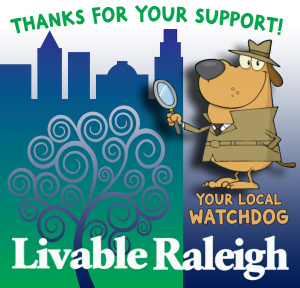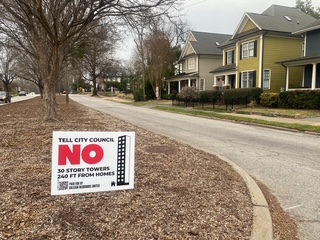

NEW DATE, TIME & LOCATION
FIRST NEIGHBORHOOD DEVELOPER MEETING
Wednesday, April 23, 6pm
1101 Gorman St, Raleigh 27606
Plan to attend, ask questions and voice your concerns
With respect to growth, Mitchell Silver says he wants to “see the city stick to its guiding plans” … “and do less deal-making over individual projects.” ¹
Raleigh neighborhood residents agree wholeheartedly. The 2030 Comprehensive Plan (2030CP), area plans such as the Capital Area Corridor Study (CBCS), (which Council Member Silver also heavily endorses), and the Equitable Transit-Oriented Development Guidebook (ETOD) are thoughtful well-developed plans offering clear guidance on height, density, transitions, historic preservation, and neighborhood protection. We all want Raleigh to thrive through smart growth by creating more housing, increasing affordable housing, supporting thoughtful transportation solutions, and expanding parks. But we also want smart, balanced growth that benefits all of Raleigh, not just a few, and these plans create a clear path for a growing vibrant city.
Please City Council, advocate for fair and equitable development around established neighborhoods and protect our unique fabric which is vital to a thriving growing city.
Established Raleigh neighborhoods are under continuous needless pressure from an increasing number of developer-driven rezoning efforts requesting inappropriate height and density that is incompatible with established plans and clear guidance. Proposed buildings of 20 to 30 stories adjacent to established neighborhoods would overpower and negatively impact their character. The resurfaced Z-54-22 zoning case on the corner of West St and Peace St, stretching three blocks along West Street, is a great example. A 30-story building (possibly 480 feet tall) located in a Transition Area and a mere 240 feet (80 yards) from single-family homes in a historic neighborhood (video link) violates the 2030CP, CBCS, ETOD (if designated as in a transit area), and all documented guidance and protections. Raleigh Neighbors United (a grassroots advocacy group striving to bring community voices together in the pursuit of responsible growth that aligns with city plans, policies, respects historic districts and neighborhoods, and incorporates real public input) provides links to analysis of these violations with respect to this rezoning case.
There are no supporting policies or plans for such egregious height, yet the developer presses on, and many on Raleigh City Council seem willing to entertain their proposal.
However, there is no need for additional height here. There are ~150,000 potential housing units in approved rezonings already; they just need to be built. Rezoning more sites is not going to help address the issues of needing more housing and more affordable housing. Also, the current zoning of 12 stories offers a significant increase in density over current conditions and significantly increases the number of housing units. A 12 story 3-acre project should provide more than ample profits to the developer, as well. Note that this same developer received triple the entitlement from 4 to 12 stories without public input in 2015. They do not need more.
If height and density of this magnitude can be forced here, without plan or policy support, where guidance clearly stipulates a maximum of 12 stories and where the site is in a Transition Area, then BEWARE! It can happen anywhere. All neighborhoods in and around Raleigh are at imminent risk.
If approved, rezoning Z-54-22 will set a dangerous precedent which will be used not only along the Bus Rapid Transit routes affecting Five Points, Oakwood, Mordecai, and Boylan Heights neighborhoods, but also near any residential neighborhood throughout the city including Hayes Barton, Washington Heights, Boylan Heights, Longview Gardens, Forest Park, King Charles, South Park, Method, Washington Heights, Longview Gardens, Fairmont, Caraleigh and other historical and culturally sensitive neighborhoods. The 2030CP, ETOD, and other plans establish guidance and parameters for fair and equitable development around established neighborhoods. We must stick to the plans!
During his campaign for City Council, Council Member Silver advocated for “keeping development consistent with our Comprehensive Plan, so that growth is predictable and new development happens in areas that make sense.” ² He stressed that “The intent [of the 2030CP] was to allow growth and density … so we can protect the established neighborhoods.” Again, we agree wholeheartedly. Follow the plans that promote balanced development and protect neighborhoods.
Historical and culturally significant neighborhoods are vital to Raleigh’s continued success. And they need protection. Plans like the 2030CP clearly offer that protection in its policies, definitions, tables and text sections (see a small sample below). We must follow the plans as written.
From the 2030CP “One of Raleigh’s major assets is its tree-lined, historic residential neighborhoods.” “The City of Raleigh desires to maintain and conserve its historic residential neighborhoods.” “Growth and development will be accommodated within Raleigh through creative solutions that conserve our unique neighborhoods.” HP 1.2 “Cultural and Historic Resource Preservation: Identify, preserve, and protect cultural and historic resources, including … neighborhoods.” Framework Section 2: 2.1 Planning Context and Key Issues: Historic Resources: “Raleigh’s historic fabric is a scarce resource requiring special effort to ensure its preservation.”
A previous Planning Commission Chair and Architect, Steve Schuster, an expert in planning and historic resources, put it best during the working session on January 6, 2015 ³ “We have multiple national registered historic districts in our downtown, and I think personally to give everyone the right to go maximum height regardless of where they are in downtown is inappropriate when there are other values of our historic properties that would all of the sudden be absolutely devalued.”
The 2030CP has more than 16 different policies and actions to help protect neighborhoods and historic neighborhoods. These are on top of the 21 policies and 2 tables on transitions, buffering, density and height. We must follow the plans and their guidance.
The future of our city is at stake. Hanging in the balance are “unique,” “scarce,” “fragile,” “distinguishable” (2030CP) neighborhoods, family homes, and a balanced and diverse urban fabric which is not only an asset to, but critical for, a thriving growing city. The decisions now being made by Raleigh City Council are rapidly reshaping our city. It is vital that the Mayor and City Council execute the existing, well-developed, thoughtful plans that will result in a vibrant and growing city that benefits all its citizens. Going against these plans and policies would set a dangerous precedent that, once established, fair or unfair, will result in a policy framework that will guide future decisions and directions for similar situations, no matter how misguided. All Raleigh neighborhoods would be at risk.
It is time for Raleigh neighborhoods and citizens to come together with a powerful voice to remind decision-makers about their accountability to provide fair, plan-compliant, and equitable development in and around neighborhoods, families and communities. We must protect a balanced vision for our city that values and engages established neighborhoods and historic areas.
Given the overwhelming evidence, there is no justification for violating so many thoughtful plans and policies aimed to help Raleigh thrive, and at the same time to marginalize and put all neighborhoods at risk. This rezoning does not make sense. We urge Raleigh City Council, the Planning Commission and Staff to “stick to the plans” that protect all neighborhoods and aim to help Raleigh thrive. Stick to the recommended heights in those plans, enforce gradual transitions in height and scale towards lower density neighborhoods, and mitigate the impact to our historic and cultural resources. (More Details)
¹ Axios May 14, 2024 “Mitchell Silver’s return to Raleigh politics”
² Mitchell’s Priorities for Raleigh
³ Planning Commission Work Session on Height, January 6, 2015 @2:25:01
NEW DATE, TIME & LOCATION
FIRST NEIGHBORHOOD DEVELOPER MEETING
Wednesday, April 23, 6pm
1101 Gorman St, Raleigh 27606
Plan to attend, ask questions and voice your concerns
The neighbors support the current zoning which allows for 12 stories.
12 stories IS DENSITY
12 stories provides needed housing
Read more about the West St proposal here: Raleigh Neighbors United
NOTE from Livable Raleigh – Mayor Cowell says she is keeping track of her email on the issue of the proposed 30-story tower at West St. If you are opposed to it and want to see Raleigh honor the Comprehensive Plan as Mayor Cowell said we should, then please email the Mayor and ALL the City Council to express your concerns. This email address will send your message to all council members: citycouncilmembers@raleighnc.gov or you can find complete contact information for each councilor and their social media accounts here: City Council Contacts
More on this proposal:
Stop Z-12-25 West St Tower – Sign the Petition
Growth with Consequences Risk to Neighborhoods
A Threat to Every Raleigh Neighborhood
Height Without Transition Risks Raleigh’s Future
The Impact of Cherry-Picking Policy – Part One
The Impact of Cherry-Picking Policy – Part Two
The Impact of Cherry-Picking Policy – Part Three
The Impact of Cherry-Picking Policy – Part Four
Is West St in the Core of Downtown?
Do City Plans have a Use By Date?
West St Tower Violates Raleigh Downtown Plan
West St Tower Violates Equitable Transit Development
West St Tower Violates the Capital Blvd Corridor Study
West St Tower Proposal Violates the Comprehensive Plan
West St Tower Neighborhood Meeting – All Stand!
Want to know more about these signs?
If you appreciate the kind of reporting we bring to you
|
Please donate $10 or $20, Thanks for supporting |
 |

